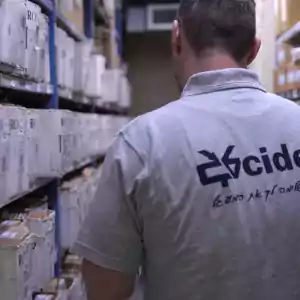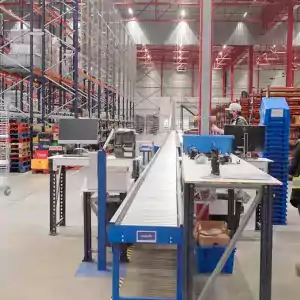Whatever the reason, whether it’s scarcity of human resources, rising labour costs, or a greater need for flexibility, warehouses and manufacturing facilities are seeking ways to automate low-value, repetitive tasks so that their operators can focus on added or higher-value activities. In this article, Amir Harel, VP of Automation & Vision at Zetes, explains how the rapid advancement of technologies such as Artificial Intelligence (AI) and Autonomous Mobile Robots (AMRs) are now boosting enterprise productivity with agentic automation and evolving to constitute a strategic lever to transform logistics execution by adding speed, precision, and safety, whilst upgrading the essential role of operatives.
AMR, AGV, and collaborative technologies: a modular, open portfolio
At Zetes, we adopt an agnostic approach to technology. The solutions we implement are based on the latest-generation AMRs chosen for their agility and embedded intelligence. We integrate models from various recognised manufacturers, such as Robotize, Zebra Robotics (Fetch), and Agilox, according to the operational needs and workflows of our customers. With such a range of options, we can offer the best-fit solution for each environment and logistics complexity.
These solutions touch every link in the internal logistics chain, from goods-in to storage, line replenishment, order preparation with dynamic or inline picking, and all the way to loading and shipping.
As with every industry over the last 2 years, the availability of AI has shown that there is the potential to evolve the way we operate fundamentally. The combination of AMRs, handling repetitive and predictable tasks, with the likes of AI, Vision, and traditional technologies such as Print and Apply and Voice Picking, enables the potential to orchestrate all logistics processes within a single execution flow, running with minimal human intervention. This unified approach guarantees significant gains in productivity and operational resilience, creating operations that are faster, smarter and safer.
“Collaborative automation does not mean replacing people with machines. It means building an ecosystem where each party brings value.”
Automation with a human focus
Despite common assumptions, the adoption of these tools is often welcomed by operators. AMRs eliminate physically arduous aspects of the job, such as excessive walking and repetitive handling, allowing people to concentrate on higher-value activities. We consistently observe a positive impact on motivation, safety, and versatility. In one of our implementations, the walking distance for warehouse colleagues was reduced by 10km per day for each operative.
Another reason for this acceptance is the system’s ease of use. We design solutions with an intuitive, training-light approach, utilising capabilities inherited from our pioneering experience in voice picking.
AI further strengthens this collaboration by ensuring AMRs integrate seamlessly into existing operations. Intelligent task allocation engines continuously balance workloads between people and robots, assigning each task to the most suitable resource. At the same time, AI-powered navigation systems continuously analyse traffic patterns, predict potential congestion, and adjust routes in real time based on evolving conditions. The result is an optimal AMR-to-people ratio where robots take over repetitive transport tasks, while human talent is directed toward judgment-based and value-adding activities.
Prerequisites and factors for success
Although collaborative automation has reached maturity, it is not a silver bullet. Each project must be based on a detailed analysis of existing processes. Success depends on identifying real operational bottlenecks, whether related to space, distance, frequency, or precision.
Physical prerequisites also matter: aisle width, floor quality, and IT connectivity. That is why our teams always carry out site audits and analyses to determine optimum deployment conditions and guarantee ROI.
Accelerating convergence
Today, it is not just about human and robotic processes coexisting; we are witnessing a true convergence. AMRs and other collaborative technologies are being integrated seamlessly into flows, working in harmony with operators.
The first use cases focus on repetitive and unproductive tasks, such as moving goods internally. But the potential goes much further. The combination of robotic precision with human intelligence is becoming the foundation for a new, more agile and resilient operational model.
AI plays a central role in this convergence. By orchestrating the interaction between AMRs and people, it ensures smooth coordination of tasks, dynamic reallocation when conditions change, and safe navigation in mixed environments. This allows warehouses to achieve a higher utilisation rate from both their human workforce and robotic fleet, while avoiding friction or downtime. In effect, AI becomes the invisible conductor, ensuring that every movement, whether human or robotic, contributes to the most efficient overall flow.
Expertise that goes beyond AMR
Zetes has ambitions that extend beyond robotic mobility. We orchestrate all intralogistics flows by combining multiple technological building blocks: machine vision (ImageID), voice solutions, unified execution platforms, and more.
A notable example is our ZetesMedea Mobile Dock Door Solution, designed to automate one of the most critical and error-prone processes in logistics: loading and unloading.
Pragmatic automation in action
The ZetesMedea Mobile Dock Door Solution automates the entire loading and unloading workflow. By detecting and decoding pallet and item barcodes automatically, it removes the need for operators to scan manually, speeding up processes, eliminating mistakes, and generating a full digital audit trail through an image bank.
Enhanced by agentic automation, the system goes far beyond simply reading barcodes. It can automatically detect forklift movements (with or without a pallet), identify and classify different types of containers or handling units, and validate that the correct types are placed on the right pallet. It also applies face blurring for privacy and GDPR compliance, while OCR technology enables reliable recognition and validation in real time.
Mobility is another key strength. An AMR can be used to position the Mobile Dock Door unit correctly, based on scheduled vehicle arrivals. This not only optimises asset utilisation since not all dock doors are active at once but also maximises utilisation of AMRs within the operation.
This solution embodies our vision perfectly: easy-to-use, AI-powered systems that create operational value, enhance data quality, and add resilience to everyday logistics processes.
Better logistics through synergy
Collaborative automation does not mean replacing people with machines. It means building an ecosystem where each party brings value: human adaptability and creativity on one hand, and robotic precision and consistency on the other.
At Zetes, we believe that this convergence will accelerate, especially for repetitive tasks with low added value. This will be key to overcoming the challenges faced by many supply chain companies, including workforce shortages, increasingly complex flows, and the need for maximum flexibility.
Ultimately, the future of the supply chain will be underpinned by AI-driven collaboration, powered by technologies such as AMRs and vision technologies. Fleets of robots will coordinate autonomously, vision systems will guarantee real-time accuracy and traceability, and humans will focus on strategic problem-solving. This synergy will not only optimise today’s warehouse but also lay the foundations for truly autonomous, resilient, and adaptive supply chains.





